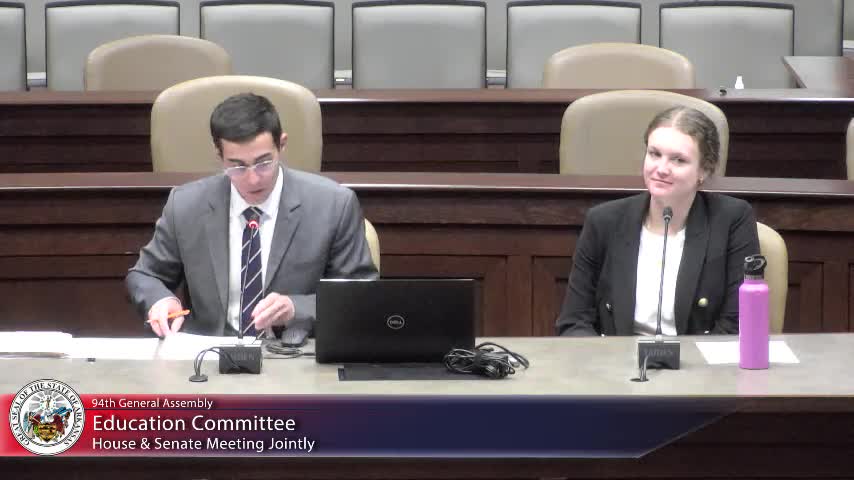States allocate supplemental funding for diverse student needs and rural districts
October 02, 2023 | EDUCATION COMMITTEE - SENATE, Senate, Committees, Legislative, Arkansas
This article was created by AI summarizing key points discussed. AI makes mistakes, so for full details and context, please refer to the video of the full meeting. Please report any errors so we can fix them. Report an error »

During a recent meeting of the Arkansas Senate Education Committee, discussions centered on the critical issue of supplemental funding for students and districts with unique needs. This topic is particularly relevant as it directly impacts the educational resources available to various student groups, including those with disabilities, English learners, and students from low-income backgrounds.
The committee highlighted findings from a comprehensive review of funding practices across all 50 states and Washington, D.C. It was noted that all states provide additional funding to support students with disabilities, separate from federal aid. Furthermore, 48 states and D.C. allocate extra resources for English Language Learners, while 44 states offer support for low-income students. This funding is essential for ensuring that these students receive the specialized services they require.
The meeting also addressed the challenges faced by rural districts, which often incur higher transportation and administrative costs due to their smaller student populations. The committee emphasized that 36 states provide additional funds for gifted and talented students, and 34 states have specific funding for small or isolated schools.
A significant point of discussion was the variation in how states identify and allocate these additional funds. Traditional methods, such as using free or reduced-price meal participation to identify low-income students, have become less reliable due to changes in meal provision policies. As a result, many states are transitioning to direct certification methods linked to federal benefit programs.
The committee shared insights into the funding mechanisms employed by different states, noting that the amount of additional aid can vary widely—from less than $200 to over $7,000 per student. This disparity underscores the need for states to conduct studies to determine appropriate funding levels based on student needs and outcomes.
Additionally, the committee touched on the emerging concept of performance-based funding, which is more prevalent in higher education. Some states are beginning to incorporate performance metrics into their funding allocations for K-12 education, potentially offering additional compensation for high-performing teachers.
As the committee continues to explore these funding strategies, the implications for Arkansas students and schools remain significant. The discussions reflect a commitment to ensuring that all students, regardless of their circumstances, have access to the resources necessary for a quality education. The outcomes of these deliberations will play a crucial role in shaping the future of education funding in the state.
The committee highlighted findings from a comprehensive review of funding practices across all 50 states and Washington, D.C. It was noted that all states provide additional funding to support students with disabilities, separate from federal aid. Furthermore, 48 states and D.C. allocate extra resources for English Language Learners, while 44 states offer support for low-income students. This funding is essential for ensuring that these students receive the specialized services they require.
The meeting also addressed the challenges faced by rural districts, which often incur higher transportation and administrative costs due to their smaller student populations. The committee emphasized that 36 states provide additional funds for gifted and talented students, and 34 states have specific funding for small or isolated schools.
A significant point of discussion was the variation in how states identify and allocate these additional funds. Traditional methods, such as using free or reduced-price meal participation to identify low-income students, have become less reliable due to changes in meal provision policies. As a result, many states are transitioning to direct certification methods linked to federal benefit programs.
The committee shared insights into the funding mechanisms employed by different states, noting that the amount of additional aid can vary widely—from less than $200 to over $7,000 per student. This disparity underscores the need for states to conduct studies to determine appropriate funding levels based on student needs and outcomes.
Additionally, the committee touched on the emerging concept of performance-based funding, which is more prevalent in higher education. Some states are beginning to incorporate performance metrics into their funding allocations for K-12 education, potentially offering additional compensation for high-performing teachers.
As the committee continues to explore these funding strategies, the implications for Arkansas students and schools remain significant. The discussions reflect a commitment to ensuring that all students, regardless of their circumstances, have access to the resources necessary for a quality education. The outcomes of these deliberations will play a crucial role in shaping the future of education funding in the state.
Don't Miss a Word: See the Full Meeting!
Go beyond summaries. Unlock every video, transcript, and key insight with a Founder Membership.
✓
Get instant access to full meeting videos
✓
Search and clip any phrase from complete transcripts
✓
Receive AI-powered summaries & custom alerts
✓
Enjoy lifetime, unrestricted access to government data
30-day money-back guarantee

